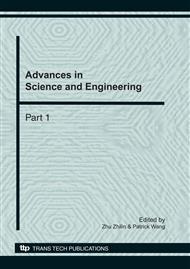[1]
Lindblad, J.M. Kinser, Image Processing Using Pulse-coupled Neural Networks, Springer Verlag, London, England, (2005).
Google Scholar
[2]
Johnson, J. L, Time Signatures of Images, Proceedings, IEEE International Conference on Neural Networks, Orlando, FL. (1994).
Google Scholar
[3]
J.M. Kinser, A simplified pulse-coupled neural network, Proc. SPIE 2760 (1996) 563–569.
Google Scholar
[4]
R. Eckhorn, H.J. Reitboeck, M. Arndt, P. Dicke, Feature linking via synchronization among distributed assemblies: Simulation of results from cat cortex Neural Comput. 2 (1990) 293.
DOI: 10.1162/neco.1990.2.3.293
Google Scholar
[5]
Ulf Ekblad, Jason M. Kinser, Jenny Atmer , Nils Zetterlund , The Intersecting Cortical Model in Image Processing[J]. Nuclear Instruments and Methods in Physics Research, Section A, 2004, 525(1-2): 392-396.
DOI: 10.1016/j.nima.2004.03.102
Google Scholar
[6]
Nazmy, T.M. Evaluation of the PCNN standard model for image processing purposes. Int. J. Intell. Comput. Inf. Sci. 4(2), 101–111.
Google Scholar
[7]
Ekblad. U , Kinser. J. M, Theoretical foundation of the intersecting cortical model and its use of change detection of aircraft, cars, and nuclear explosion tests. Signal Process. 84, 1131–1146.
DOI: 10.1016/j.sigpro.2004.03.012
Google Scholar
[8]
Y. Ma, Li Liu et al. Pulse-coupled neural networks and one-class support vector machines for geometry invariant texture retrieval[J]. Image Vis. Comput. doi: 10. 1016/j. imavis 2010. 03. 006.
DOI: 10.1016/j.imavis.2010.03.006
Google Scholar
[9]
Guangzhu Xu, Zaifeng Zhang, Yide Ma, A novel method for iris feature extraction based on intersecting cortical model network[J]. Journal of Applied Mathematics and Computing, Volume 26, Numbers 1-2, (2008, 2), 341-352.
DOI: 10.1007/s12190-007-0035-y
Google Scholar
[10]
Wang Zhaobin et al,. A Novel Method of Iris Feature Extraction Based on the ICM[C]. 2006 IEEE Proceedings of International Conference on Information Acquisition, 2006: 814-818.
DOI: 10.1109/icia.2006.305836
Google Scholar
[11]
Johnson J L. Pulse-Coupled Neural Nets: Translation, Rotation, Scale, Distortion, and Intensity Signal Invariance for Images[J]. Applied Optics, 1994, 33(26): 6239-6253.
DOI: 10.1364/ao.33.006239
Google Scholar
[12]
Johnson J L, Ritter D. Observation of Periodic Waves in a Pulse-Coupled Neural Network[J]. Optics Letters, 1993, 18(15): 1253-1255.
DOI: 10.1364/ol.18.001253
Google Scholar
[13]
G. Kuntimad H.S. Ranganath. Perfect Image segmentation using pulse coupled neural networks, IEEE Trans. Neural Networks, 1999, 10(3), pp.591-598.
DOI: 10.1109/72.761716
Google Scholar


